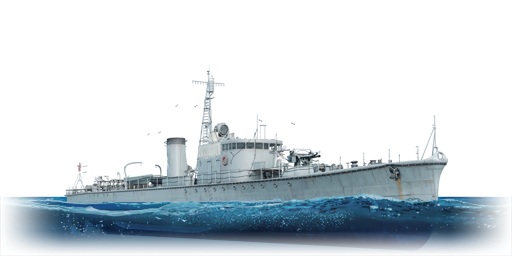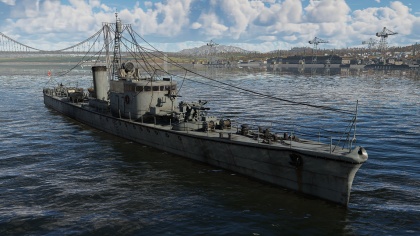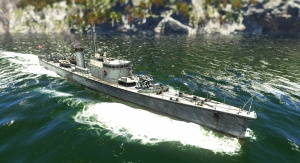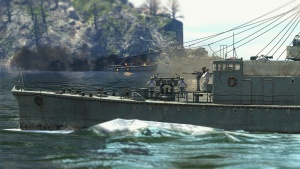Difference between revisions of "Type K-7 No.4"
Inceptor57 (talk | contribs) m (→Pros and cons) |
Jareel_Skaj (talk | contribs) (→History: Created) |
||
| Line 74: | Line 74: | ||
== History == | == History == | ||
| − | ''Describe the history of the creation and combat usage of the ship in more detail than in the introduction. If the historical reference turns out to be too long, take it to a separate article, taking a link to the article about the vehicle and adding a block "/ History" (example: <nowiki>https://wiki.warthunder.com/(Vehicle-name)/History</nowiki>) and add a link to it here using the <code>main</code> template. Be sure to reference text and sources by using <code><nowiki><ref></nowiki></code>, as well as adding them at the end of the article.'' | + | <!-- ''Describe the history of the creation and combat usage of the ship in more detail than in the introduction. If the historical reference turns out to be too long, take it to a separate article, taking a link to the article about the vehicle and adding a block "/ History" (example: <nowiki>https://wiki.warthunder.com/(Vehicle-name)/History</nowiki>) and add a link to it here using the <code>main</code> template. Be sure to reference text and sources by using <code><nowiki><ref></nowiki></code>, as well as adding them at the end of the article.'' --> |
| + | The No.4-class submarine chasers (第四号型駆潜艇, Dai 4 Gō-gata Kusentei) were built under Maru 3 Keikaku programme, totaling 9 ships built in 1938 and 1939. Vessel was a direct improvement over the Type K-4 / No.3 Class (not present in the game, it was a less substantial upgrade of the [[Type K-3 / No.1 Class]]). Design called for an improved range by 25% over No.1 Class, while maintaining the same speed and improving its blue water stability. Major factor in improving stability was lowering a center of mass, what pulled a number of alterations, most notably: lowering the height of the superstructure and rising the freeboard. Ship's waterline length was 55.5 meters, width 5.6 meters for a total displacement of 296 tonnes. Crew consisted of 59 sailors. | ||
| + | |||
| + | Armament was identical to the No.1, however a new class introduced one important innovation: Sonar. While its predecessor's mode of engagement was to spot submarine by visual means (which realistically was limited to the surfaced submarines), approach its last known location and drop depth charges in semi-random pattern, No.4 would attempt to re-establish contact underwater and more precisely determine enemy's position before committing. This was still a flawed tactic, as early Japanese sonars struggled detecting submarines straight underneath the boat, it significantly increased chances of a successful attack. | ||
| + | |||
| + | The first ship of the class was launched on 10 June 1938 and completed 15 November 1938, it was designated No.7 and built by the Tsurumi Iron Works Dockyard (鶴見製鉄造船). Class was built by 4 different shipyards, hence the launch dates were not in order. | ||
| + | |||
| + | ===Ships of class=== | ||
| + | {| class="wikitable sortable" | ||
| + | ! rowspan="2" data-sort-type="text" | Name | ||
| + | ! data-sort-type="isoDate" rowspan="2" | Completed | ||
| + | ! colspan="3" | Fate at the end of the war | ||
| + | ! rowspan="2" data-sort-type="text" | Dismantled<br/>post-war | ||
| + | ! rowspan="2" | Notes | ||
| + | |- | ||
| + | ! data-sort-type="text" | {{Annotation|Status|As of 1945-08-15}} | ||
| + | ! data-sort-type="text" | By | ||
| + | ! data-sort-type="isoDate" | {{Annotation|Date|Date of event that contributed to its status at the end of the war}} | ||
| + | |- | ||
| + | | No. 4 | ||
| + | | 1938-12-28 | ||
| + | | Severely Damaged | ||
| + | | Struck a mine in Madura Strait, Java sea | ||
| + | | 1945-08-13 | ||
| + | | Unknown | ||
| + | | Turned over to Allies and sold to an unknown party | ||
| + | |- | ||
| + | | No. 5 | ||
| + | | 1938-12-06 | ||
| + | | Damaged | ||
| + | | Gunfire from surfaced submarines (USS Capitaine (SS-336) and USS Baya (SS-318)) | ||
| + | | 1945-06-30 | ||
| + | | 1946-07-11 | ||
| + | | Turned over to British | ||
| + | |- | ||
| + | | No. 6 | ||
| + | | 1939-05-20 | ||
| + | | Sunk | ||
| + | | Aircraft | ||
| + | | 1944-06-30 | ||
| + | | | ||
| + | | Sunk at anchorage during US operation ''Desecrate One'' | ||
| + | |- | ||
| + | | No. 7 | ||
| + | | 1938-11-15 | ||
| + | | Sunk | ||
| + | | Aircraft | ||
| + | | 1945-04-11 | ||
| + | | | ||
| + | | Sunk by a group of four Liberator VI's of No. 201 Squadron RAF near Nicobar Islands, Andaman Sea | ||
| + | |- | ||
| + | | No. 8 | ||
| + | | 1938-11-30 | ||
| + | | Sunk | ||
| + | | Gunfire from surfaced submarines (HMS Trenchant (P331) and HMS Terrapin (P323)) | ||
| + | | 1945-03-04 | ||
| + | | | ||
| + | | Sunk at Malacca Strait | ||
| + | |- | ||
| + | | No. 9 | ||
| + | | 1939-05-09 | ||
| + | | Survived | ||
| + | | | ||
| + | | | ||
| + | | 1960 | ||
| + | | Turned over to Taiwan on 1947-10-03, served as a patrol vessel Hai Hong (海宏), later Ya Long (雅龍), finally Qu Jiang PC-107 (渠江) | ||
| + | |- | ||
| + | | No. 10 | ||
| + | | 1939-06-15 | ||
| + | | Grounded | ||
| + | | | ||
| + | | 1944-05-01 | ||
| + | | | ||
| + | | Abandoned after running ashore at the Angaur Island, Palau atoll. Currently sunk, scuba-diving attraction | ||
| + | |- | ||
| + | | No. 11 | ||
| + | | 1939-02-02 | ||
| + | | Sunk | ||
| + | | Aircraft | ||
| + | | 1943-11-06 | ||
| + | | | ||
| + | | Sunk west of Buka Town by the [[B-25 (Family)|B-25]] of the USAAF Thirteenth Air Force | ||
| + | |- | ||
| + | | No. 12 | ||
| + | | 1939-05-09 | ||
| + | | Sunk | ||
| + | | Submarine, USS Bluegill (SS-242) | ||
| + | | 1944-08-13 | ||
| + | | | ||
| + | | Sunk east of Mindanao, Philippines | ||
| + | |} | ||
== Media == | == Media == | ||
Revision as of 00:03, 17 April 2020
Contents
Description
The Type K-7 No.4, Kusentei is a rank III Japanese sub-chaser
with a battle rating of 3.0 (AB/RB/SB). It was introduced in Update 1.89 "Imperial Navy".
General info
Survivability and armour
The K-7 is unarmoured apart from the 6mm of steel making up the hull, it does have a total of 59 crew members however which does buff its survivability somewhat, as lower caliber guns will struggle to quickly sweep this ship of its crew. However the large size of the vessel does artificially lower its survivability, as this makes it much easier to hit at all ranges, on top of this its also not the fastest vessel around, so it will catch a lot of damage. Overall though it's one of the more survivable vessels around its battle rating.
Mobility
For its size the K-7 isn't exactly slow, at 37 km/h in RB modes, and 56 km/h in AB modes. It's nowhere close to the speed of many smaller vessels, but for a large sub-chaser it can make its way around the map fairly easily, and despite its size has enough reactive mobility to dodge enemy torpedoes if noticed early enough, it can quite easily change direction at speed but due to the size, does take a while to decelerate to a stop.
Armament
Primary armament
The K-7 is equipped with a twin mounting of the 40mm Vickers autocannon, which is an exceptionally powerful and versatile weapon weapon, it has a very fast fire rate and high damage output, in tandem with a very fast traverse rate, this makes reacting to enemy vessels and aircraft very easy, and because of the fast fire rate the damage output is very consistent, it comes with four belts-
- Universal- A mix of HE and APHE rounds, good all-rounder, but not the most effective.
- HE- Majority HE belt, great for attacking unarmoured vessels, very high damage output with a small amount of APHE rounds if you do come across an armoured vessel.
- SAP- Majority APHE, low penetration but very effective against armoured vessels.
- HE-DF- HE with a timed fuse shell, very effective against aircraft and enemy vessels alike.
The K-7 has a lot of viable options for for the 40mm cannons, the HE-DF belt acts essentially as a full HE belt, so it will damage enemy aircraft and boats very efficiently, however it contains no APHE rounds so this belt cannot damage armoured vessels, but as the reload speed is fairly short, it is a viable to consider taking a full HE-DF belt, and a second belt containing APHE rounds to switch to if an armoured vessel needs to be engaged. Another somewhat overlooked advantage of taking HE-DF rounds is that when detonating on an enemy vessel, they create a large cloud of smoke and shake the enemy players screen slightly, which can be fairly useful for temporarily panicking or disorienting your enemies.
Secondary armament
The K-7 is equipped with three single mountings of the 25 mm Type 96 autocannon, which makes for a very potent secondary weapon. The HE type rounds this gun fires will have no trouble knocking out PT boats and even larger support vessels, sometimes even wiping out an enemy boat in one magazine all together. The cannons can cover a fairly wide area together, they all individually have blind-spots but there's no total deadzone for all the cannons, which makes knocking out ships sneaking up on your rear a lot easier. Additionally due to the HE these cannons can engage targets at range and still do damage. This cannon can also cause critical damage to aircraft with only a single hit. The cannon comes with three belts: universal, APT belts and HEI belts.
- Universal belts: good balance between firepower and tracer contents, useful for newcomers to the Japanese 25 mm autocannon.
- APT belts: Full of AP shells, it's recommended to take a few belts of AP in case you meet a Russian armoured river boat.
- HEI belts: Trades tracer rounds for extra firepower, harder to aim but very good at knocking out PT boats and aircraft.
Special armament
The K-7 can carry a total of 18 Type 95 depth charges which can be dropped to maim other naval targets. Four of the charges are placed in a mortar arrangement that fire off the sides of the vessel to engage targets at the sides at a further range. They have rather limited viability though as most MTBs will be able to outrun the explosion. However they are useful in the event of being rushed by a smaller naval vessel, as if the drop is timed right the depth charges can easily take out enemies performing this manoeuvre.
Usage in battles
The K-7 is a very functional vessel, it has the ability to effectively combat every type of vessel and aircraft, which can't be said about a lot of ships. The most important thing to keep in mind while playing the K-7 is to try and minimise taking damage, the vessel is very large, and if played in a location that's easily visible it will slowly take a large amount of damage, a good way to try and limit damage to the hull is to point the hull front directly at the vessel you're engaging, this way the compartments towards the back of the vessel are immune to damage, playing it in this way can be a detriment potentially though as this angle makes it much easier for enemies to knock out the 40mm cannon mounting at the front, but it is the best way to position yourself to minimise damage.
Something else to be wary of are torpedo boats on your sides, as this vessel is very long and takes a while to adjust speed, an incoming torpedo from the side will be hard to doge, if you see an incoming enemy boat it's a good idea to immediately take evasive action to preemptively avoid a torpedo, this vessel is very narrow, so avoiding a torpedo from the front will be much easier. Be conscious of enemies trying to attack you from behind as well, and periodically check your surroundings just in case an enemy MTB is sneaking up on you, as if you notice too late, it will be quite hard to dodge a torpedo or a run of depth charges, this vessel is quite vulnerable to this kind of attack.
This vessel is somewhat limited to close range engagements, the 40mm guns have a fairly low velocity, so accurately landing shots past 2,000 meters will be quite difficulty if your enemy is fairly mobile, at close range the the rounds will be easy aim, and can usually take out a small enemy vessel in just one sweep of rounds across the hull. A possible advantage to this is that the rounds can arc over cover to land on enemies hiding behind the terrain, it can be difficult to find the correct ranging but it is possible to take out enemies completely hidden behind cover, which is a fairly unique advantage to this vessel.
Pros and cons
Pros:
- Very effective primary weapon
- Versatile ammo options for attacking all types of vessel
- Fast traverse rate on the main cannons
- Versatile secondary armament
- HE-DF rounds are very useful against enemy vessels in close quarter battles
Cons:
- Low overall speed
- Large target, easy to hit
- Very long vessel, easy to torpedo from the side
History
The No.4-class submarine chasers (第四号型駆潜艇, Dai 4 Gō-gata Kusentei) were built under Maru 3 Keikaku programme, totaling 9 ships built in 1938 and 1939. Vessel was a direct improvement over the Type K-4 / No.3 Class (not present in the game, it was a less substantial upgrade of the Type K-3 / No.1 Class). Design called for an improved range by 25% over No.1 Class, while maintaining the same speed and improving its blue water stability. Major factor in improving stability was lowering a center of mass, what pulled a number of alterations, most notably: lowering the height of the superstructure and rising the freeboard. Ship's waterline length was 55.5 meters, width 5.6 meters for a total displacement of 296 tonnes. Crew consisted of 59 sailors.
Armament was identical to the No.1, however a new class introduced one important innovation: Sonar. While its predecessor's mode of engagement was to spot submarine by visual means (which realistically was limited to the surfaced submarines), approach its last known location and drop depth charges in semi-random pattern, No.4 would attempt to re-establish contact underwater and more precisely determine enemy's position before committing. This was still a flawed tactic, as early Japanese sonars struggled detecting submarines straight underneath the boat, it significantly increased chances of a successful attack.
The first ship of the class was launched on 10 June 1938 and completed 15 November 1938, it was designated No.7 and built by the Tsurumi Iron Works Dockyard (鶴見製鉄造船). Class was built by 4 different shipyards, hence the launch dates were not in order.
Ships of class
| Name | Completed | Fate at the end of the war | Dismantled post-war |
Notes | ||
|---|---|---|---|---|---|---|
| Status | By | Date | ||||
| No. 4 | 1938-12-28 | Severely Damaged | Struck a mine in Madura Strait, Java sea | 1945-08-13 | Unknown | Turned over to Allies and sold to an unknown party |
| No. 5 | 1938-12-06 | Damaged | Gunfire from surfaced submarines (USS Capitaine (SS-336) and USS Baya (SS-318)) | 1945-06-30 | 1946-07-11 | Turned over to British |
| No. 6 | 1939-05-20 | Sunk | Aircraft | 1944-06-30 | Sunk at anchorage during US operation Desecrate One | |
| No. 7 | 1938-11-15 | Sunk | Aircraft | 1945-04-11 | Sunk by a group of four Liberator VI's of No. 201 Squadron RAF near Nicobar Islands, Andaman Sea | |
| No. 8 | 1938-11-30 | Sunk | Gunfire from surfaced submarines (HMS Trenchant (P331) and HMS Terrapin (P323)) | 1945-03-04 | Sunk at Malacca Strait | |
| No. 9 | 1939-05-09 | Survived | 1960 | Turned over to Taiwan on 1947-10-03, served as a patrol vessel Hai Hong (海宏), later Ya Long (雅龍), finally Qu Jiang PC-107 (渠江) | ||
| No. 10 | 1939-06-15 | Grounded | 1944-05-01 | Abandoned after running ashore at the Angaur Island, Palau atoll. Currently sunk, scuba-diving attraction | ||
| No. 11 | 1939-02-02 | Sunk | Aircraft | 1943-11-06 | Sunk west of Buka Town by the B-25 of the USAAF Thirteenth Air Force | |
| No. 12 | 1939-05-09 | Sunk | Submarine, USS Bluegill (SS-242) | 1944-08-13 | Sunk east of Mindanao, Philippines | |
Media
Excellent additions to the article would be video guides, screenshots from the game, and photos.
See also
Links to the articles on the War Thunder Wiki that you think will be useful for the reader, for example:
- reference to the series of the ship;
- links to approximate analogues of other nations and research trees.
External links
[Development] No.4 Type CH-8: Bomb truck
| Japan sub-chasers | |
|---|---|







